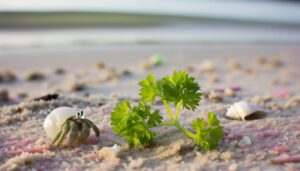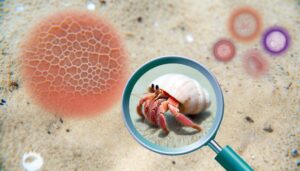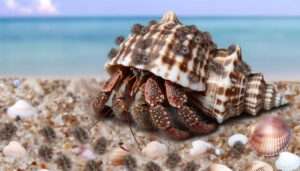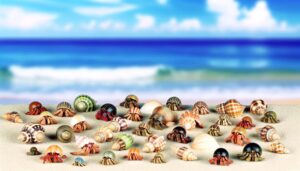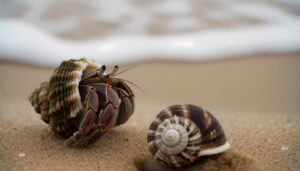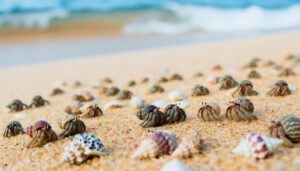How Do Hermit Crabs Live in Water?
Yes, hermit crabs do live in the ocean. You'll encounter them in various coastal habitats like sandy beaches, mangrove forests, intertidal zones, and tide pools.
They've adapted remarkably, using abandoned shells for protection and displaying specific behaviors for survival. Some species, like Parapagurus pilosimanus, even inhabit the deep sea, equipped with specialized gills and bioluminescent organs.
Despite facing natural predators and human-induced threats, their roles in coastal ecosystems remain pivotal. These adaptations and behaviors highlight their resilience and significance in marine biodiversity.
To understand their remarkable survival strategies and the need for conservation efforts, explore further.
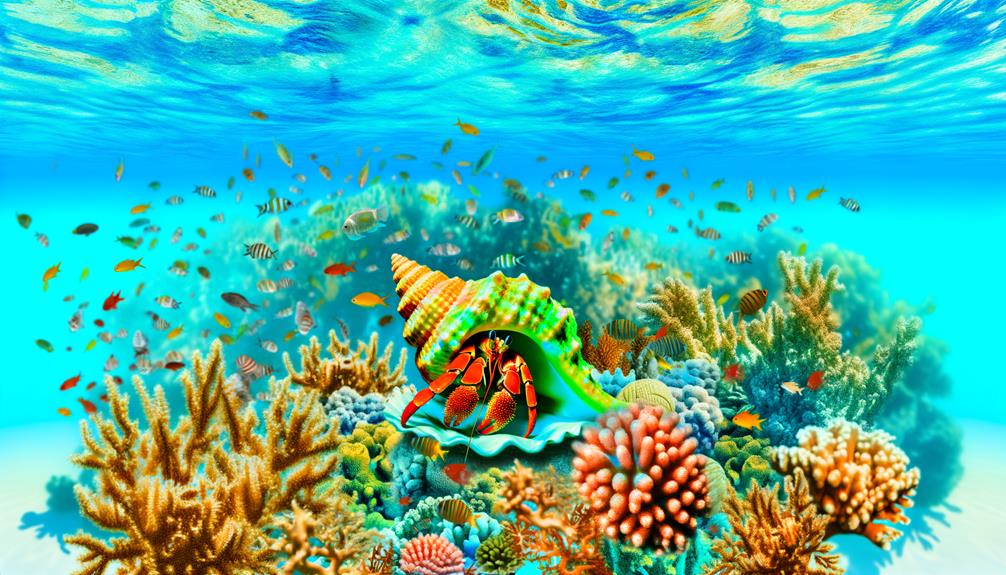
Key Takeaways
- Hermit crabs occupy various coastal habitats, including intertidal zones and tide pools.
- Deep-sea hermit crabs like Parapagurus pilosimanus thrive in oceanic environments with specialized adaptations.
- Hermit crabs use abandoned shells for protection in both coastal and oceanic habitats.
- Coastal hermit crabs contribute to ecosystem health by participating in nutrient cycling.
- Both coastal and deep-sea hermit crabs face natural predators and human-induced threats in ocean environments.
Hermit Crab Species
Among the myriad species of hermit crabs inhabiting the world's oceans, the most studied include the Caribbean hermit crab (Coenobita clypeatus) and the Japanese land hermit crab (Coenobita brevimanus), each exhibiting unique physiological and behavioral traits.
You'll find that Coenobita clypeatus, commonly known as the 'purple pincher,' is recognized for its robust exoskeleton and adaptive respiratory system, allowing it to thrive in both terrestrial and marine environments.
In contrast, Coenobita brevimanus, with its shortened appendages, demonstrates remarkable shell selection behaviors essential for protection against predators.
Both species employ distinct feeding strategies, utilizing their chelipeds to forage for organic detritus and small invertebrates, ensuring their survival.
Understanding these traits helps in conservation efforts and educational outreach programs.
Coastal Habitats
Understanding the diverse species of hermit crabs sets the stage for examining the intricate coastal habitats they occupy, where tidal patterns, substrate types, and vegetation play pivotal roles in their ecological niches.
You'll find these crabs in sandy beaches, rocky shores, and mangrove forests, each offering distinct microhabitats. Tidal patterns influence their access to food and shelter, while substrate types—ranging from fine sand to coarse gravel—affect their mobility and burrowing behavior. Vegetation such as seagrasses and algae provides essential cover and foraging opportunities.
Studies show that hermit crabs exhibit habitat-specific adaptations, like preference for certain shell types or behavioral traits, ensuring their survival and contributing to coastal ecosystem health. Your understanding of these dynamics aids in conservation efforts.
Intertidal Zones
You'll observe hermit crabs employing remarkable habitat adaptation strategies in intertidal zones, such as utilizing abandoned shells for protection.
These zones present significant survival challenges, including fluctuating temperatures and predation risks.
Evidence shows that hermit crabs exhibit behavioral and physiological adaptations to thrive under these harsh conditions.
Habitat Adaptation Strategies
Hermit crabs thrive in intertidal zones by utilizing a combination of behavioral adaptations and physiological mechanisms to endure fluctuating environmental conditions. You'll find them retreating into shells to prevent desiccation during low tide and foraging during high tide when moisture levels are higher. They also possess specialized gills allowing respiration in both air and water, adapting seamlessly to tidal shifts.
| Adaptation Type | Behavior/Mechanism | Environmental Benefit |
|---|---|---|
| Behavioral | Retreating into shells | Prevents desiccation |
| Behavioral | Foraging during high tide | Access to food resources |
| Physiological | Specialized gills | Respiration in air and water |
| Behavioral | Climbing rocks | Avoids predators |
| Physiological | Salt regulation | Balances internal salt levels |
These strategies showcase the hermit crab's remarkable ability to adapt and thrive in challenging intertidal habitats.
Survival Challenges Faced
While their adaptation strategies are impressive, hermit crabs also face numerous survival challenges in the intertidal zones, including predation, extreme temperature fluctuations, and competition for limited resources.
Predators such as gulls, fish, and octopuses frequently target them, making their shells essential for protection. Extreme temperatures from tidal changes can cause thermal stress, affecting their metabolism and survival rates.
In addition, the availability of suitable shells is limited, leading to intense competition among hermit crabs. Studies indicate that this competition can influence their growth and reproductive success.
You'll appreciate how these challenges underscore the resilience and adaptability of hermit crabs, emphasizing the importance of conserving their habitats to support their survival and ecological role.
Tide Pools
Nestled between the ebb and flow of the tides, tide pools serve as dynamic micro-ecosystems where hermit crabs thrive, displaying fascinating adaptations to their fluctuating environments. You'll find these resilient creatures maneuvering rocky crevices, utilizing various empty shells for protection. They exhibit behaviors such as frequent shell exchanges and scavenging for food, ensuring their survival despite the harsh conditions.
| Feature | Adaptation |
|---|---|
| Shell Selection | Frequent exchange to fit growing bodies |
| Mobility | Maneuvering rocky terrain with specialized legs |
| Feeding Behavior | Scavenging and opportunistic feeding habits |
| Environmental Tolerance | Surviving fluctuating salinity and temperature |
These adaptations illustrate the hermit crabs' remarkable ability to adjust to the changing conditions of tide pools, ensuring their thriving presence in these unique coastal habitats.
Deep Sea Dwellers
You'll find that deep-sea hermit crabs exhibit distinct adaptations enabling survival in high-pressure, low-light environments. Species like Parapagurus pilosimanus possess specialized gills for oxygen extraction and bioluminescent organs to navigate the dark ocean depths.
These adaptations indicate evolutionary responses to the extreme conditions of the deep sea, supported by numerous observational studies and pressure-resilience experiments.
Deep-Sea Hermit Crab Species
Deep-sea hermit crabs, thriving in the abyssal zones, exhibit remarkable adaptations like bioluminescence and specialized gill structures to survive in extreme oceanic conditions.
You'll find species like Parapagurus pilosimanus and Pagurus albus residing thousands of meters below the surface. These hermit crabs rely on scavenging for detritus and carrion, making them pivotal in nutrient cycling.
Their bioluminescence likely serves as a defense mechanism in the pitch-black environment, deterring predators. Specialized gill structures enable efficient oxygen extraction from the cold, low-oxygen water.
Adaptations for Ocean Depths
Understanding the significant adaptations of deep-sea hermit crabs introduces a broader spectrum of survival strategies employed by oceanic dwellers to endure high-pressure, low-light environments.
You'll find that these crabs possess specialized exoskeletons, which withstand immense pressure. Their chemoreceptors are highly developed, enabling them to locate food in pitch-black waters. Additionally, bioluminescence, a common adaptation, aids in both predation and evasion.
To serve these unique creatures, it's essential to recognize their reliance on symbiotic relationships with deep-sea anemones for protection and camouflage. Their metabolic rates are adapted to scarce food availability, optimizing energy use.
Shell Selection
Hermit crabs carefully select their shells based on size, weight, and availability to guarantee peak protection and mobility. When you observe them, you'll notice they evaluate potential shells meticulously. They measure the aperture to make sure it fits snugly around their abdomen, providing a secure grip.
Research indicates that hermit crabs prefer shells that aren't too heavy, allowing them to move efficiently and escape from potential dangers. Availability is also essential; they often compete for the best shells, which can lead to aggressive interactions.
Predators and Threats
You should understand that hermit crabs face numerous predators such as octopuses and larger crabs, which can greatly impact their populations.
Additionally, human activities like pollution and coastal development pose severe threats, disrupting their habitats and food sources.
Natural Ocean Predators
Frequently encountering natural ocean predators, hermit crabs face threats from larger marine animals such as octopuses, fish, and seabirds that have evolved specialized hunting techniques to target them. Octopuses use their dexterous tentacles to extract crabs from their shells. Fish, particularly triggerfish, employ strong jaws to break shells and consume the crabs within. Seabirds, like gulls, dive to snatch hermit crabs from the shallows.
| Predator | Hunting Technique |
|---|---|
| Octopus | Uses tentacles to extract crabs |
| Triggerfish | Breaks shells with strong jaws |
| Seabirds | Dives to snatch from shallows |
These predators' diverse methods highlight the constant vigilance hermit crabs must maintain. Understanding these interactions aids in developing conservation strategies to protect these vulnerable creatures.
Human-Induced Threats
In addition to natural predators, human activities have greatly increased the threats to hermit crabs. The primary factors contributing to these threats include pollution, habitat destruction, and climate change. Plastic pollution poses a significant danger to hermit crabs as it can trap them, leading to injury or death. Chemicals from agricultural runoff contaminate their habitats, disrupting their reproductive cycles. Coastal development further compounds the issue by destroying critical habitats, reducing the availability of shells necessary for their protection. Climate change exacerbates these challenges by altering ocean temperatures and acidifying waters, negatively impacting both shell availability and the overall health of hermit crabs.
Your efforts in reducing plastic use, supporting sustainable agriculture, and advocating for coastal conservation can make a significant difference in protecting hermit crabs and their habitats. By understanding these threats and taking action to address them, you can help preserve the delicate balance of marine ecosystems and ensure the survival of hermit crabs for future generations.
Environmental Challenges
Hermit crabs face numerous environmental challenges, including predation from various marine animals and threats from human-induced factors. Predators such as octopuses, larger crabs, and fish constantly target them, exploiting their relatively soft exoskeleton. Moreover, pollution and habitat destruction exacerbate these threats, leading to a decline in their populations. You'll find that hermit crabs must adapt their behavior and shell selection to mitigate these risks.
| Threat Category | Examples | Impact on Hermit Crabs |
|---|---|---|
| Predation | Octopuses, Fish | Increased mortality |
| Pollution | Plastic debris | Shell contamination |
| Habitat Destruction | Coastal development | Loss of habitat |
Feeding Habits
Despite their seemingly scavenger-like behavior, hermit crabs exhibit a highly specialized and opportunistic approach to feeding, adapting their diet based on the availability of various food sources within their marine environment.
You'll find that they consume a diverse array of organic materials, including algae, plankton, and detritus. They also capitalize on carrion, which provides crucial nutrients.
Hermit crabs use their chelae to manipulate and break down food particles, maximizing nutrient intake. Studies indicate that their feeding patterns shift with tidal and seasonal changes, ensuring optimal foraging efficiency.
Reproduction
Reproductive behaviors in hermit crabs are complex and involve intricate mating rituals, which are influenced by environmental factors such as tidal cycles and lunar phases.
You'll observe males engaging in a unique behavior called 'claw tapping' to attract females. This is often synchronized with the high tide, optimizing the chances of successful mating.
Females release pheromones to signal readiness, ensuring the timing aligns with the lunar phases. Post-mating, females carry fertilized eggs in their pleopods until they hatch.
The larvae, called zoeae, are released into the ocean where they undergo multiple developmental stages. Understanding these behaviors can help you create environments that support their natural reproductive processes, ensuring the continuation of their species and promoting ecological balance.
Adaptations
How do hermit crabs adapt to their ever-changing marine environment, utilizing their unique behaviors and physiological traits to enhance survival and reproduction?
You'll find that these fascinating creatures exhibit several key adaptations.
- Shell Selection: Hermit crabs meticulously choose shells that provide optimal protection against predators and environmental stressors.
- Exoskeleton Molting: Regular molting allows for growth and the replacement of damaged exoskeleton parts, essential for maintaining mobility and defense.
- Gills Adaptation: Their gills are adapted to extract oxygen efficiently from both water and air, enabling survival in intertidal zones.
- Antennal Sensory Organs: Highly developed sensory organs help them detect food sources, mates, and avoid dangers in their dynamic habitats.
These adaptations showcase the hermit crabs' remarkable capability to thrive amidst constant environmental fluctuations.
Human Impact
In recent years, the increasing levels of pollution, habitat destruction, and climate change have greatly impacted hermit crab populations and their marine ecosystems.
You'll notice that plastic pollution clogs the coastal waters, often mistaken by hermit crabs for shells, leading to injury or death.
Deforestation and coastal development destroy their natural habitats, reducing available resources.
Rising sea temperatures and ocean acidification, direct consequences of climate change, disrupt their reproductive cycles and food sources.
Data from marine biologists highlight a significant decline in hermit crab populations, illustrating the urgent need for intervention.
Conservation Efforts
Recognizing the dire threats posed by human activities, various conservation efforts have been implemented to safeguard hermit crab populations and restore their marine habitats.
You can actively contribute to these initiatives. Here are some key strategies:
- Habitat Restoration: Rehabilitating damaged coral reefs and seagrass beds where hermit crabs thrive.
- Pollution Control: Reducing plastic waste that often ends up in oceans, preventing entanglement and ingestion by marine life.
- Sustainable Shell Collection: Ensuring that shell collection for the pet trade doesn't deplete natural resources critical for hermit crabs.
- Public Awareness Campaigns: Educating local communities and tourists about the ecological importance of hermit crabs and advocating for responsible behavior.
Conclusion
Just like Odysseus steering through treacherous seas, hermit crabs face numerous challenges in their diverse habitats. From intertidal zones to the deep ocean, these crustaceans adapt remarkably to survive.
However, human impact threatens their existence. You can help by supporting conservation efforts and reducing pollution. Remember, every action counts.
By protecting these resilient creatures, you're contributing to the intricate web of marine life, ensuring their story continues for future generations to study and admire.

